- HOME
- Enzyme List
- SAO-351 SARCOSINE OXIDASE
SAO-351
SARCOSINE OXIDASE from Microorganism

PREPARATION and SPECIFICATION
| Appearance | Yellowish amorphous powder, lyophilized | |
|---|---|---|
| Activity | GradeⅢ 8.0 U/mg-solid or more | |
| Contaminants | Catalase | ≤1.0 % |
| Stabilizers | Potassium chloride | |
PROPERTIES
| Stability | Stable at −20 ℃ for at least one year (Fig.1) |
|---|---|
| Molecular weight | approx.43,000 (by SDS-PAGE) |
| Isoelectric point | 4.8±0.1 |
| Michaelis constant | 2.8×10-3 M |
| Inhibitors | Cu2+, Ag+, Hg2+, p-chloromercuribenzoate, N-ethylmaleimide, SDS |
| Optimum pH | 7.5−8.5 (Fig.2) |
| Optimum temperature | 55−60 ℃ (Fig.3) |
| pH Stability | 6.0−9.5 (25 ℃, 20 hr) (Fig.4) |
| Thermal stability | below 60 ℃ (pH 7.5, 30 min) (Fig.5) |
| Effect of various chemicals | (Table.1) |
APPLICATIONS
This enzyme is useful for enzymatic determination of creatinine, creatine, and sarcosine, in combination with creatinine amidohydrolase (CNH-211, CNH-311) and creatine amidinohydrolase (CRH-211, CRH221, CRH-229).
ASSAY
Principle

Unit definition
One unit causes the formation of one micromole of hydrogen peroxide (half a micromole of quinoneimine dye) per minute under the conditions detailed below.
Method
Reagents
| A. Sarcosine solution | 0.2 M: Weigh out 1.78 g of sarcosine (MW = 89.09), dissolve in 80 mL of 0.125 M TrisHCl buffer, pH 8.0, containing 0.125 % Triton X-100, and, after adjusting to pH 8.0 at 25 ℃ with 1.0 N NaOH or 1.0 N HCl, make up to 100 mL with H2O (stable for 1 week if stored at 0−5 ℃). |
|---|---|
| B. 4-AA solution | 0.1 %: 100 mg of 4-aminoantipyrine / 100 mL of H20 (store at 4 ℃ in a brownish bottle). |
| C. Phenol solution | 0.1 %: 100 mg of phenol / 100 mL of H2O (store at 4 ℃ in a brownish bottle). |
| D. Peroxidase solution | 0.025 %: 25 mg of peroxidase (110 purpurogallin units / mg) / 100 mL of H2O (should be freshly prepared). |
| E. SDS solution | 0.25 %: 1.25 g of sodium dodecyl sulfate / 500 mL of H2O |
| F. Enzyme diluent | 20 mM Tris-HCl buffer, pH 8.0 containing 2.0 mM EDTA |
Procedure
1.Prepare the following working solution(for 100 tests) in a brownish bottle and store on ice.
| 50 mL | Sarcosine solution | (A) |
|---|---|---|
| 10 mL | 4-AA solution | (B) |
| 20 mL | Phenol solution | (C) |
| 20 mL | Peroxidase solution | (D) |
| Concentration in assay mixture | |
|---|---|
| Tris-HCl buffer | 48 mM |
| Sarcosine | 95 mM |
| 4-Aminoantipyrine | 0.47 mM |
| Phenol | 2.0 mM |
| Triton X-100 | 0.045% |
| POD | Approx. 5.2 U/mL |
2.Pipette 1.0 mL of working soluton into a test tube and equilibrate at 37 ℃ for approximately 5 minutes.
3.Add 0.05 mL of the enzyme solution* and mix.
4.After exactly 10 minutes at 37 ℃, add 2.0 mL of SDS solution (E) to stop the reaction, and measure the optical density at 500 nm against water (OD test).
At the same time, prepare the blank using the same method as for the test except that the enzyme diluent is used instead of the enzyme solution (OD blank).
*Dissolve the enzyme preparation in ice-cold enzyme diluent (F) and dilute to 0.07−0.17 U/mL with the same buffer, immediately before the assay.
Calculation
Activity can be calculated by using the following formula :
Volume activity (U/mL) =
-
ΔOD (OD test−OD blank)×Vt×df
13.3×1/2×1.0×t×Vs
= ΔOD×0.917×df
Weight activity (U/mg) = (U/mL)×1/C
| Vt | : Total volume (3.05 mL) |
| Vs | : Sample volume (0.05 mL) |
| 13.3 | : Millimolar extinction coefficient of quinoneimine dye under the assay condition (cm2/micromole) |
| 1/2 | : Factor based on the fact that one mole of H2O2 produced half a mole of quinoneimine dye |
| t | : Reaction time (10 minutes) |
| 1.0 | : Light path length (cm) |
| C | : Enzyme concentration in dissolution (c mg/mL) |
REFERENCES
1) N.Mori, M.Sato, Y.Tani and Y.Yamada; Agric.Biol.Chem., 44, 1391 (1980).
2) M.Suzuki; J. Biochem., 89, 599 (1981).
3) M.Suzuki and M.Yoshida; Proceedings of the Symposium on Chemical Physiolosy and Pathology (Kyoto), Vol16, p.220 (1976).
4) T.Kinoshita and Y.Hiraga; Chem.Pharm.Bull., 28, 3501 (1980).
5) Y.Nishiya, S.Zuihara and T.Imanaka; APPLIED AND ENVIROMENTAL MICROBIOLOGY., 61, 367 (1995).
Table 1. Effect of Various Chemicals on Sarcosine oxidase
[The enzyme dissolved in 50 mM K-phosphate buffer, pH 7.5 (10 U/mL) was incubated at 30 ℃ for 30 minutes.]
-
Chemical Concn.(mM) Residual
activity(%)None - 100 Metal salt 2.0 MgCl2 99 CaCl2 99 Ba(OAc)2 98 FeCl3 99 CoCl2 98 MnCl2 99 Zn(OAc)2 98 Cd(OAc)2 99 NiCl2 96 CuSO4 43 Pb(OAc)2 98 AgNO3 0.4 HgCl2 0.4 PCMB 2.0 36 MIA 2.0 101 -
Chemical Concn.(mM) Residual
activity(%)NAF 2.0 99 NaN3 20.0 90 EDTA 5.0 97 o-Phenanthroline 2.0 99 α,α′-Dipyridyl 2.0 97 Borate 50 98 IAA 2.0 97 NEM 2.0 74 Hydroxylamine 2.0 97 Triton X-100 0.10% 99 Brij 35 0.10 % 99 Tween 20 0.10 % 97 Span 20 0.10 % 101 Na-cholate 0.10 % 99 SDS 0.05 % 68 DAC 0.05 % 97
Ac, CH3CO; PCMB, p-Chloromercuribenzoate; MIA, Monoiodoacetate; EDTA, Ethylenediaminetetraacetate;
IAA, Iodoacetate; NEM, N-Ethylmaleimide; SDS, Sodium dodecyl sulfate; DAC, Dimethylbenzylalkylammonium chloride.
-
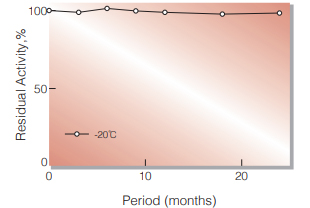
Fig.1. Stability (Powder form)
(kept under dry conditions)
-
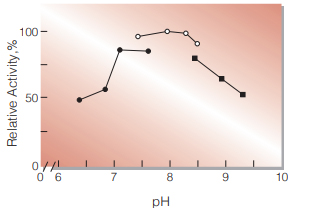
Fig.2. pH-Activity
37 ℃ in 0.1 M buffer solution : pH 6.5-7.5 K-phosphate,:pH 7.5-8.5 Tris-HCl:pH 8.5-9.5 Glycine-NaOH
-
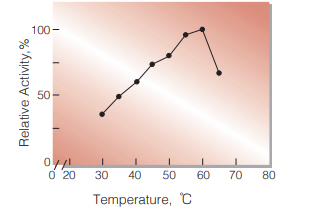
Fig.3. Temperature activity
(in 0.1 M Tris-HCI buffer : pH 8.0)
-
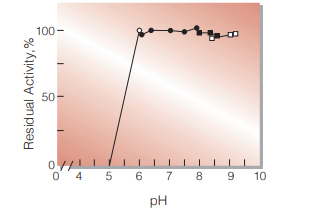
Fig.4. pH-Stability
25 ℃,24hr-treatment with 100 mM buffer solution:pH 5-6 Acetate buffer, :pH 6-8 K-phosphate,:pH 8-9 Tris-HCl, :pH 8.5-9.5 Glycine-NaOH
-
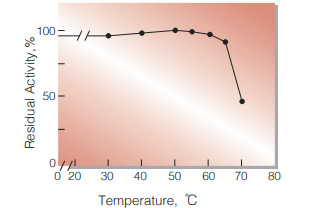
Fig.5. Thermal stability
30 min-treatment with 50 mM K-phosphate pH 7.5 (contg. 100 mM NaCl) enzyme concn. 5 U/mL
活性測定法(Japanese)
1. 原理

4-AminoantipyrineとPhenolの酸化縮合物である Quinoneimine色素を500nmで測定し,上記反応で生成したH2O2量を定量する。
2.定義
下記条件下で1分間に1マイクロモルのH2O2を生成する酵素量を1単位(U)とする。
3.試薬
- 0.2Mサルコシン溶液〔1.78gのサルコシン(MW= 89.09)を80mlの0.125%Triton X-100を含む 0.125M Tris-HCl緩衝液, pH8.0に溶解後,1.0N のNaOHあるいはHClでpHを8.0に調整(25℃)し, 蒸留水で100mlとする〕(0~5℃保存で1週間は使用可能)8
- 0.1%4-AA水溶液(100mgの4−アミノアンチピリンを100mlの蒸留水に溶解する)(褐色瓶中で4℃ 保存)
- 0.1%フェノール水溶液(100mgのフェノールを100ml の蒸留水に溶解する) (褐色瓶中で4℃保存)
- POD溶液〔25mgのペルオキシダーゼ(POD)(110 プルプロガリン単位/mg)を蒸留水100mlに溶解する〕(用時調製)
- 0.25%SDS水溶液〔1.25gのsodium dodecyl sulfate(SDS)を500mlの蒸留水に溶解する〕
酵素溶液:酵素標品を予め氷冷した2.0mM EDTAを含む20mM Tris-HCl緩衝液, pH8.0で溶解し, 分析直前に同緩衝液で0.07〜0.17U/mlに希釈する。
4.手順
1.下記反応混液を調製する(褐色瓶にて氷冷保存)。
| 50ml | サルコシン溶液 | (A) |
| 10ml | 4-AA水溶液 | (B) |
| 20ml | フェノール水溶液 | (C) |
| 20ml | POD水溶液 | (D) |
2.反応混液1.0mlを試験管に採り,37℃で約5分間予備加温する。
3.酵素溶液0.05mlを加え,反応を開始する。
4.37℃で正確に10分間反応させた後,SDS水溶液 (E)2.0mlを加えて反応を停止させる。この液につき 500nmにおける吸光度を測定する(OD test)。
5.盲検は酵素溶液の代わりに酵素希釈液(2.0mM EDTAを含む20mM Tris-HCl緩衝液, pH8.0)を用い, 上記同様に操作を行って吸光度を測定する(OD blank)。
5.計算式
-
U/ml =
-
ΔOD (OD test−OD blank)×3.05(ml)×希釈倍率
13.3×1/2×1.0×10(分)×0.05(ml)
| = ΔOD×0.917×希釈倍率 | |
| U/mg | = U/ml×1/C |
| 13.3 | : Quinoneimine色素の上記測定条件下でのミリモル分子吸光係(cm2/micromole) |
| 1/2 | : 酵素反応で生成したH2O2の1分子から形成するQuinoneimine色素は1/2分子である事による係数 |
| 1.0 | : 光路長(cm) |
| C | : 溶解時の酵素濃度(c mg/ml) |
CONTACT
-
For inquiries and cosultations regarding our products, please contact us through this number.
- HEAD OFFICE+81-6-6348-3843
- Inquiry / Opinion
